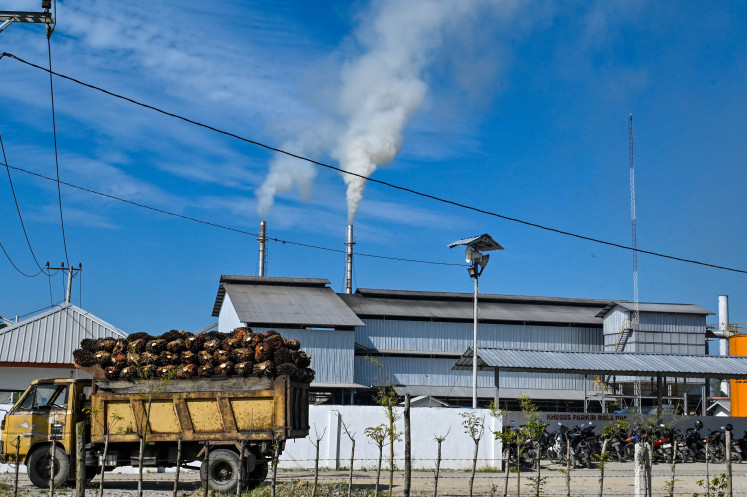Popular Reads
Top Results
Can't find what you're looking for?
View all search resultsPopular Reads
Top Results
Can't find what you're looking for?
View all search resultsKiluan Bay: Dolphins and sightseeing
The tail of a dolphin is seen in Kiluan Bay
Change text size
Gift Premium Articles
to Anyone
T
span class="caption" style="width: 378px;">The tail of a dolphin is seen in Kiluan Bay. At the right moment and spot, schools of dolphins can be seen around the bay. JP/Ani Suswantoro
A few hours away from its capital of Bandarlampung, Lampung province hosts a wide range of tourist destinations.
Tourists have many choices of places to visit. They can visit an elephant training site in Way Kambas where they can travel on top of the pachyderm or visit Bukit Barisan National Park for a visual feast.
If you like the sea, you can go to Tanjung Setia Beach where you can also enjoy the breezes of the Sunda Strait while watching the majesty of Mount Krakatau (but not now though, as the nearby Mount Anak Krakatau is showing signs of volcanic activity).
Another interesting site is Kiluan Bay, where tourist can get a breathtaking sight of wild dolphins swimming and jumping around the bay. Pioneer of the tourism project is ecotourism foundation Cikal, chaired by Riko Stefanus which has been instrumental in introducing the site to the outside world.
Before the establishment of Cikal in 2005, Kiluan was an isolated area.
“Were it not for Pak Riko’s work, we would not have seen any tourists here,” Ketut, 40, a Balinese living in Kiluan, said.
In 2007, a visit by Lampung’s Governor to the location has resulted in the renovation of public facilities, including school buildings. The following year, a wide road was built allowing cars to access the remote place.
An ojek brings visitors through a coconut plantation to Kiluan Bay. JP/Ani Suswantoro
Kiluan Bay offers extraordinary attractions for visitors. People have a chance to see dolphins swimming and jumping in the bay. Tourists can also watch turtles laying eggs on the beach.
To attract more visitors, local people have also included water sports on the list of attractions, combining recreation and natural beauty. It’s a mixture of the sea with green hills that are teeming with wild animals.
“We can see dolphins all year round, although they are more plentiful from June to July,” Riko said.
Green sea turtles (Chelonia Mydas) and Hawksbill turtles (Eretmochelys imbricate) can still found breeding around the beach there, despite earlier times when they were hunted.
Kiluan can be reached by car from Bandar Lampung. Contact Cikal for transportation arrangement. If you want to reach it by sea, you can take a boat from the Lempasing fish auction center in Panjang, Bandar Lampung.
Alternatively, you can rent a car. Please ensure that the driver and the vehicle are in very good condition as the roads connecting Padang Cermin subdistrict and Kiluan Bay are quite challenging.
The road from Bandar Lampung to Padang Cermin is relatively smooth. When you pass the Hanura subdistrict, you can sample the spicy Pindang Kepala Simba fish soup at Ika Restaurant, which is located 50 meters before the Hanura traditional market.
The route from Padang Cermin to Bawang Village is accessible by four-wheel drive. The road is unpredictable — smooth stretches followed by spots of deep puddles.
There are three alternatives when you depart from Bawang Village. If you are adventurous and consider yourself a skilled driver, you may continue to Kiluan Bay. Otherwise you might hire a motorcycle taxi, or walk and leave the vehicle at Bawang.
The long walk can provide you with picturesque pastoral scenes of traditional Lampung houses, coconut trees, green rice fields, cocoa, pepper and coffee plantations.
Bahar, 30, drives his boat to take visitors around the water of Kiluan Bay to watch dolphins. Mount Anak Krakatau is seen in the horizon. — JP/Ani Suswantoro
The last five kilometers from Bawang to Kiluan are partly paved with gravel, dirt, and concrete and will really test your driving skill. Parts of the road are steep and often grow muddy or slippery after the rain. You can find a narrow wooden bridge barely passable by a vehicle and a broken bridge that will force you cross a small brook.
The small passage has a sharp turn so drivers should check the direction before going ahead, otherwise their cars could flip over.
“The road to Kiluan will be repaired this year as soon as funds from the provincial administration are available,” said Yaman Aziz from the Lampung’s cultural and tourism office.
In Kiluan, visitors can rent a boat for Rp 250,000 (US$28) for a trip to watch dolphins, visit white sandy beaches or stop by some islands. Most boats are small and can carry only three passengers.
There two species of dolphin in Kiluan Bay: spinner dolphins (Stenella longirostris) and common bottlenose dolphins (Tursiops Truncattus). They live in warm tropical waters, such as the Indian Ocean, and have chosen Kiluan Bay as a resting point between Semaka to Lampung Bay.
Silhouettes of three people are seen in Kiluan Bay as the light from the sunset offers a picturesque scene. — JP/Ani Suswantoro
Dozens — sometimes hundreds — of dolphins surface and frolic at dawn or when the days are cloudy, so watch for them in the early morning. People can stay at cottage for Rp 250,000 a night, while a homestay will cost Rp 100,000. Meals are provided by the owner for Rp 15,000 per person.
I stayed at the Cikal base camp, a simple house nestled right in front of Kiluan Bay. Behind the camp is a hill — home to siamangs (Symphalangus syndactylus), an arboreal , black furred gibbons.
If you’re lucky, you can hear them exchange calls in the morning. Honey bears (Helarctos malayanus), Brahminy kites (Haliastur indus) and various songbirds also inhabit the hilly forest.
Unfortunately, floating trash spoils part of Kiluan’s beauty.
“Yes, some people litter on the beach, but trash also comes from cities along the coast of Lampung Bay and from the open water, carried by the western wind,” Yaman said.
“The paradox with the trash is, some fish, like dolphinfish (Coryphaena hippurus) and red snappers love to hide under it,” Riko said.
“I think the root of the trash issue can be found in our culture and even deeper in the gears of industrial globalization. Thus, it requires strong initiatives to hit the subliminal thinking of people. I hope ecotourism in Kiluan would have positive outcomes,” said Gregory Simkiss, a 22-years-old American tourist.
Kiluan Bay, the once-isolated and pristine region, is now exposed. Like two sides of a coin, there are blessings and curses. We hope the region gets the blessing! As such, Kiluan’s natural richness is preserved.
— Photos by Ani Suswantoro













